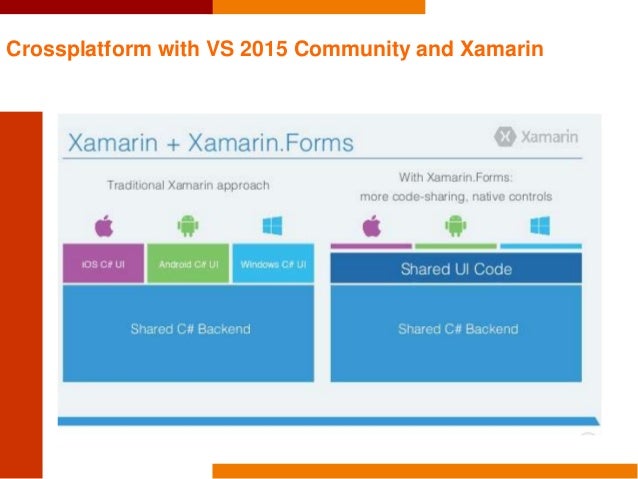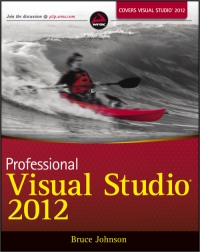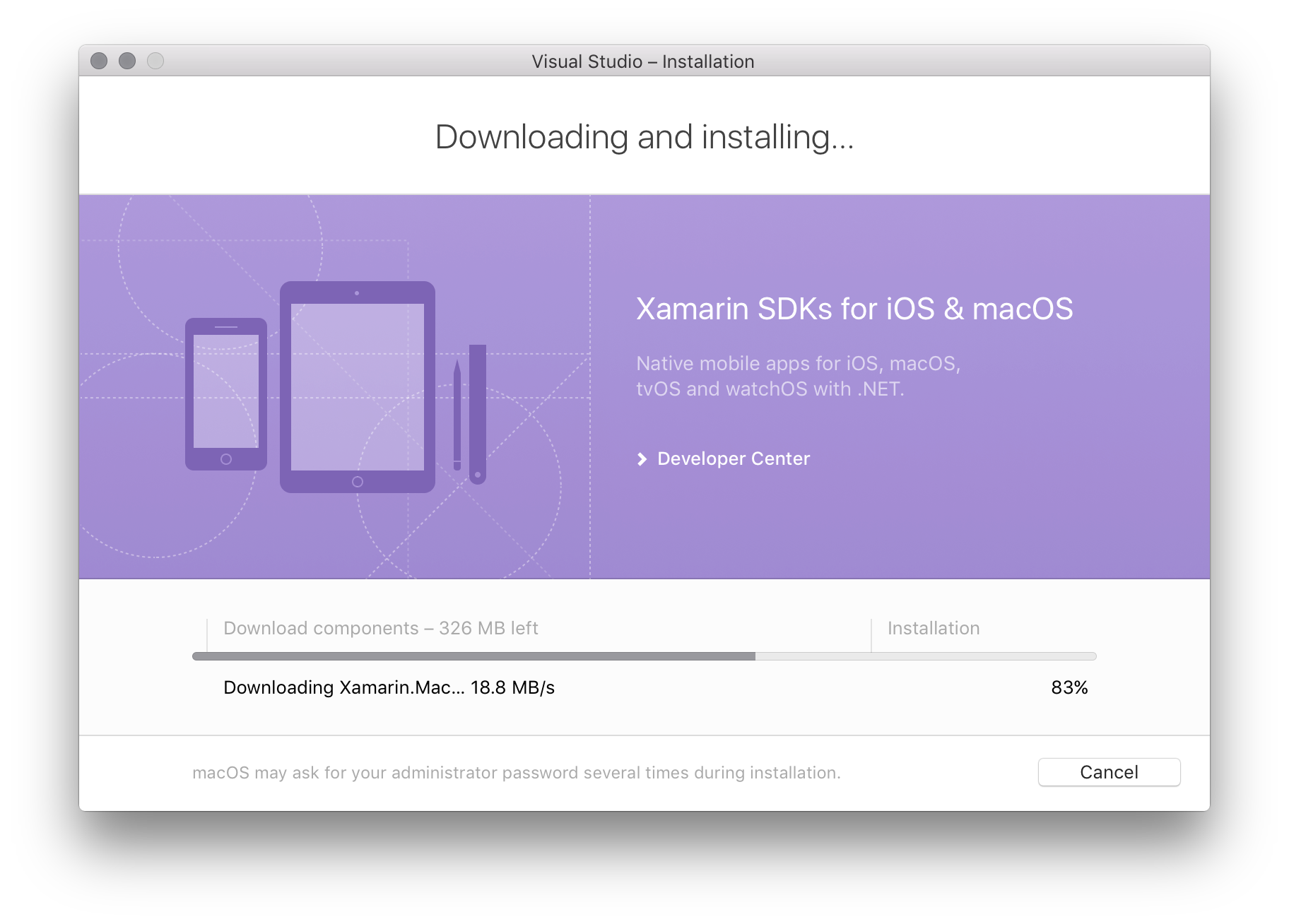Parallels Desktop for Mac is a hypervisor-based virtualization solution that makes it easy to run any number of operating systems inside separate windows on your Mac desktop. For developers, this means you can simultaneously run Xcode on Mac and Visual Studio on Windows 8. The Parallels window behaves like a normal Mac window, so you can copy content from your desktop and place it directly into the Parallels virtual machine instance just as you would from one Mac window to another. You can even run Visual Studio (and other Windows applications) directly on the Mac OS X desktop (no Windows VM window, just the app).
And in the course Visual Studio Development on a Mac, you'll witness the impact a virtual machine running Windows and Visual Studio has on its host, the Mac OS X. This smooth performance is in the details of Apple's hardware and the cleverness of the virtual machine software. VS for Mac is the re-branded Xamarin IDE - so you can use that tool to create “native mobile and Mac Apps” (Visual Studio for Mac) VS Code has many of the features of the “full” Visual Studio like debugging, embedded Git control, syntax highlighting, intelligent code completion, snippets, and code refactoring.
Visual Studio for Mac is a powerful developer tool that reinforces Microsoft’s “mobile-first”, “cloud-first”, and “any developer, any platform, any device” strategy. With the author's guided expertise and extensive code samples, you will understand how to leverage the most useful tools in Visual Studio for Mac, the code editor. Visual studio 2005 runs just fineeeee on my macbook in winxp @superbovine, i need vs for some of my classes.lame, but.that was actually a teeny part of why i wanted a laptop capable of dualbooting xp and OS X.visual studio and games on one, and everything else on the other.
For cross-platform development of iOS apps, Windows Store Apps, and Windows Phone 8 apps, Parallels is unparalleled since you can work with two different operating systems and related dev tools at the same time, in the same session, from the same desktop.
Here, Kurt Schmucker, a product manager at Parallels, gives a brief summary of Parallels Desktop and demonstrates how to run Windows 8 and Visual Studio 2012 on your Mac without rebooting to a Windows partition first. Kurt demonstrates the Visual Studio Windows Phone emulator running along side the Xcode iPhone emulator.
My job is currently based on Visual Studio (ASP.NET).
Looking for experiences using Visual Studio on a Mac.
Does it work?
closed as primarily opinion-based by Undo♦, hichris123, user2888561, Anonymous, DavidMay 12 '14 at 3:38
Many good questions generate some degree of opinion based on expert experience, but answers to this question will tend to be almost entirely based on opinions, rather than facts, references, or specific expertise. If this question can be reworded to fit the rules in the help center, please edit the question.
19 Answers
In a word, yes.
I use a Mac Mini 1.67 GHz machine with 2GB of RAM. That's not an impressive box, but performance under WinXP is excellent. I have used VS2005, VS2008, MySQL Server, Sql Server Express, and dozens of little utilities.
The only issues I've ever had were when I used a hotkey (ex: F10) that was assigned to something like Expose in the mac. So I would hit F10 and instead of stepping over, it would bring up the weather widget. Workaround was to reassign those keys on the Mac (i.e., reassign to Shift+F10).
Edit:

I see others report having sluggish performance. You may want to get an extra drive and keep your Virtual Drive there. I've been doing that for a long time, and that may be the reason for good performance under XP. Jeff Atwood has a blog entry about this topic.
JosephStyonsJosephStyonsVisual Studio For Mac
I run Visual Studio 2008 on a Mac via the Parallels desktop and it works perfectly.
Lots of people are talking about Parallels and VMWare Fusion, but I didn't see any mention of the other methods I've used to good effect.
Visual Studio via Remote Desktop - I have a laptop running Windows/Visual Studio with a static IP and use the Microsoft Remote Desktop client to connect from my Mac. This has the advantage of minimal overhead on the Mac, so is more responsive than a VM. However, it has the obvious disadvantage of requiring a second machine running Windows and Visual Studio. If you're running Windows Server 2008, as a bonus you can run RemoteApp to share just Visual Studio to your mac - very convenient.
Virtual machine using VirtualBox - All the major features of a VM, except VirtualBox is free. I've used VMs with VMWare Fusion, Parallels and VirtualBox and I have to say I find performance to be pretty much even across all three. Parallels tended to drive my CPU harder than the other two but the actual VM responsiveness was fine. VirtualBox also has Seamless mode, essentially similar to Parallel's Coherence mode, but less integrated into the Desktop. I use this every day to run a Windows-only application on my Mac and it works great, sharing only the window for that application instead of running a full Windows desktop.
Boot Camp - depending on your needs, running Boot Camp with Windows installed as a dual-boot OS will of course offer the best performance but with the downside of running Windows ;)
Some default replacements for Home/End et al.:
- Start-of-File: Fn-Ctrl-Left
- End-of-File: Fn-Ctrl-Right
- Page-Up: Fn-Up
- Page-Down: Fn-Down
- Start-of-Line: Fn-Left
- End-of-Line: Fn-Right
- Delete: Fn-Delete
- F1: Fn-F1
- ...
- F12: Fn-F12
Yes it does, using VMWare Fusion. It works quite well, actually; the Unity feature allows you to treat Visual Studio in its own Mac window. However, you will need a current version of OS X (10.5.x), a LOT of RAM (more than 4GB), and a lot of hard drive space, as you will need to install all of Windows in your VM.
Jon DavisJon DavisI've run it in VMWare Fusion (and Parallels previously) on several Macs with 2 gig of RAM without any issues. I generally install with BootCamp because that lets you boot into 'native' Windows if you need more 'umph' (or if you want to game), and the more recent versions of VMWare and Parallels both allow booting the VM directly from the BootCamp partition.
Steven Robbins Steven Robbins
Steven RobbinsI am working on an IMac now using VS2008 through BootCamp using Vista. I have tried it using Parallels and found it to be very slow at times. Using BootCamp it is a dream though (apart from having to reboot if you want to use OSx.) I would recommend the BootCamp route.
I use Base Camp and I run Vista w/ VS 2008 on a MacBook Pro. I think it's the bees knees. Mac may make crappy dirty hippie software but they make some rockin hardware.
Sara Chipps♦Sara ChippsI do this a bit, but I find the keyboard on a MBP miserable for VS/R# - the home/end/page-up/page-down differences/omissions are particularly tedious.
Will DeanWill DeanVirtualization is the only way I know.If you want to do .NET work in a native IDE I suggest MonoDevelop
Bramha GhoshI'm running VMWare Fusion on an iMac with 3GB memory. 1.5GB memory is allocated to the Windows XP that lives in the virtual world. The performance is very satisfying overall, but seems sluggish when I open or compile large C# projects. I am using visual studio 2008.
It definitely works using VMware or Parallels. I've used it in both and it worked far better in VMware Fusion. Things to keep in mind:
- You want lots of RAM. My MacBook Pro has 6GB, with 2GB allocated to the VM
- Defrag often. A fragmented drive is especially slow under virtualization
- Compress unused space often. You're VM will quickly consume many GB as the compiler creates lots of new files
- Use Windows XP. It's way faster.
Good luck!
Paul LefebvrePaul LefebvreVS.2008 under XP/Vista/Win7. The tradeoff is whether you want faster compiles or more fan noise. If I need the power, the VM gets to virtualize both cores, then studio becomes much zippier. However, it tends to annoy the fans.
All things considered, it's very slick.
Like Stephen Doyle I use Parallels Desktop.
I'm currently running Parallels Desktop 4.0 on an old MackBook Pro with 2GB and its a bit slow.
In my last job I had a MacBook Pro with 4GB. I used Parallels Desktop 3.0 and ran VS2008 in a VM with 1.5GB memory. It worked well.
ewalsheewalsheMac Visual Studio Code
Personally, I am a big fan of VMWare Fusion. You can not only run the development environment of your choice, but setup test sandboxes to deploy and view your application through. I have a crusty XP install running IE6 just to make sure that my applications are passable by its poor standards.
Make sure you've got plenty of RAM for your Mac!
I'm using a 2.66 dual-core MacBook Pro 4gb RAM, VS2008 + XP in Parallels and I'm not having the best experience. Sadly, another hard drive is not an option and if I were to get an external hard drive, I'm not sure why I wouldn't just go back to a Windows laptop that doesn't need extra hardware. Others seem to have had a good experience with this set up though so I'm going to continue to tweak my settings. So far I'm kinda regretting having bought a Mac but not quite enough yet to take the financial hit of selling it on eBay.
DinahDinahIf you have an Intel mac and run windows through boot camp, paralles or vmware etc, yes

I have not tried any of the stuff mentioned above but from what I have read, it seems VMware Fusion seems to be the most preferred option by many. The Unity feature of Fusion seems to give a sense of running your VS2008 on Mac itself.
Aoi KarasuVisual Studio
I run VS 2008 / SQL 2008 on a MistakeBook Pro. I thought Parallels and Fusion kinda sucked for development. Bootcamp is pretty good though, just no native drivers to read the Mac partition of the hard drive. Also the windows 7 drivers are still lacking, the trackpad does not work. Still better than OSX.
Shawn